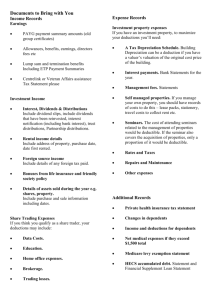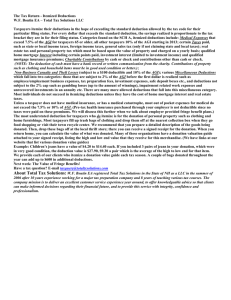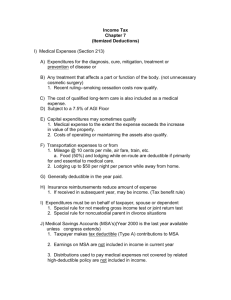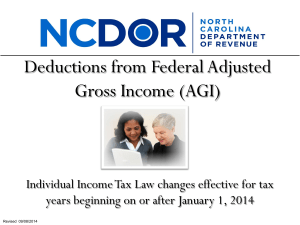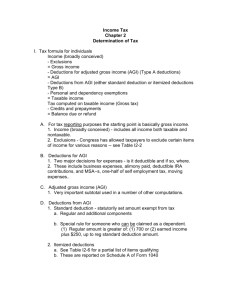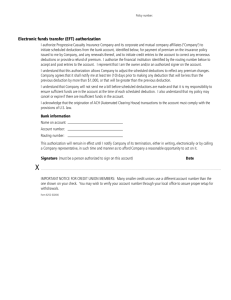Finalreview
advertisement
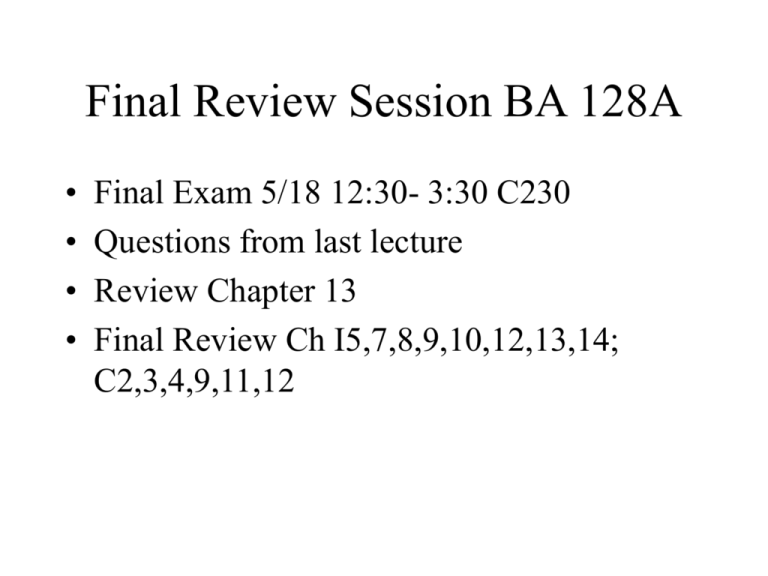
Final Review Session BA 128A • • • • Final Exam 5/18 12:30- 3:30 C230 Questions from last lecture Review Chapter 13 Final Review Ch I5,7,8,9,10,12,13,14; C2,3,4,9,11,12 Chapter 13 Estate Tax Estate tax formula Gross estate - deductions (expenses, debts & losses) =Adjusted gross estate - deductions (marital and charitable) = Taxable Estate + Adjusted taxable gifts (post 1976) = Estate Tax Base Tentative tax (current uniform transfer tax rates) - Post 1976 gift taxes (current uniform transfer tax rate) - unified credit taken in year gift taxes are paid - unified credit (full amount) - other credits = Estate Tax payable Deductions • Expenses - administrative expenses for managing the estate, funeral expenses • Debts - personal liabilities e.g. mortgage • Casualty and theft losses - incurred while estate is being settled • Marital and Charitable deductions - no ceiling Valuation of estate • FMV at date of death or alternate valuation date • Alt. Valuation - all or nothing • FMV at date of death - price at which property would change hands between a willing buyer and seller • exception - life insurance - valued at face value • listed stock - average of low and high price; if sale takes place within a few days of death date, use wtd average of high and low stock price on the nearest trade dates before and after date of death • Other valuation - Block stock, non-public stock, real estate, annuities Chapter 5 Capital G/L • ST < 1yr, LT > 1yr; deduct loss up to $3000, gain taxed at 20% except uncolletibles, 1250 unrecapture and section 1202 • Netting of CL and CG – net STCL and STCG – net LTCL and LTCG – NLTCG > NSTCL = NCG – adjusted NCG is NCG without uncollectibles, section 1250 unrecapture and then sec1202 small bus stock – both NLTCL and NSTCL - use NSTCL first - retain character of loss – NSTCL > NLTCG - net highest rate group first (ie 28%, 25% and then 20%) Chapter 5 • Realized vs. recognized gain • Property basis – received as gift - usually donor’s basis except if FMV < basis, donee has 2 basis (if sold at gain later, basis = donor’s basis, else basis = FMV) – Gift tax paid by donor increase donee’s basis – property from decedent - FMV – property convert from personal to business - lower of FMV or adjusted basis – basis of stock dividend – basis of stock rights Chapter 7- itemized deductions • Deduct only if it exceeds standard deduction • Subject to phase out - 3% of amount exceeds threshold. Qualified medical expenses • Taxes • Qualified interest • Casualty and theft losses • Miscellaneous deductions – Non reimbursed employee expenses – Investment expenses – Cost of tax advice • Charitable Contributions Qualified Medical Expenses • • • • • • • • Deduct the amount that exceed 7.5% of AGI No deduction it it is reimbursed Include taxpayer, taxpayer’s spouse and dependent Diagnosis, cure, mitigation, treatment and prevention of disease, medical procedures involving function or structure of body - except cosmetic surgery unless for deformity correction Transportation for medical reasons Long term care Capital expenditures for medical care - add a swimming pool, remove physical barriers Medical insurance premiums Classification of interest • Active trade and business - for AGI • Passive activity - e.g. rental activity - for AGI - Chapter 8 • Investment interest - offset investment income - from AGI • Personal interest - not deductible • Qualified residence - from AGI • Student loan - for AGI Investment Interest • Investments - generates portfolio of income such as interest, dividends, annuities and royalties, not personal or business, not passive and not tax exempt securities • Net investment income = Investment income investment expenses. Investment income include net gain to the extent that net gain exceeds net capital gain • Taxpayer can elect to include net capital gain in investment income that will be subject to regular tax rates • Investment expenses only deductible to the extent that it is >2% of AGI - ie this is the amount used to calculate net investment income Other interest • Qualified residence interest – – – – Principal + secondary residence Secured by home Acquisition indebtedness - up to $1,000,000 Home equity interest - can only deduct the amount applied to the lesser of FMV of qualified residence in excess of acquisition indebtedness or $100,000 • Student Loan interest – – – – For higher education expenses FOR AGI deduction Maximum deductible amount = $1000 in 1998. Phased out ratably for AGI between 40,000 and 50,000 Charitable Contribution limitation amount • Max - 50% of AGI • depends ORGANIZATION contributed to and TYPES of property contributed • Excess is carry forward for the subsequent 5 years • Capital gain property contributed to public charity is limited to 30% of AGI • Ordinary and cash property contributed to private nonoperating foundation is also limited to 30% of AGI • Contributions of capital gain property to private nonoperating foundation are limited to the lesser of 20% of taxpayer’s AGI or 30% of taxpayer’s AGI reduced by capital gain contributed to public charity • Contributions to athletics events in return for the right to purchase tickets (80% limitation) • Apply 50% limitation contributions first and then the 30% limitation • Carryover amounts subject to the same % limitations. Deductions for current year is applied first. Charitable contributions - basis • Except capital property contributed to public charity (at FMV), all other transactions, used adjusted basis (or FMV capital gain) • Transactions include ordinary and capital gain property to private nonoperating foundations, capital gain property that is unrelated use in nature - special circumstances - donation of inventory and scientific equipment - higher than adjusted basis Chapter 8 loss and bad debts • Sale or exchange of property - capital asset result in capital loss, property in bus/trade e.g. inventory, accounts receivable, depreciable property and land used in a trade or business - ordinary loss (section 1231 subject to netting rules (I13) • Abandonment of property - ordinary loss • Demolition of property not deductible - add to basis of land • Other disallowed loss - wash sales, like kind exchange, related party transaction, transfer of property to a controlled corp in exchange for stock Passive loss • Definition - any rental activity or any trade/business where taxpayer does not materially participate • Passive loss can only net against passive income and can be carried over (each activity). Suspended losses of passive activity is deductible against ordinary income upon disposition ownership interest • Rental activity excluding real property trade/business • $25000 deduct against ordinary income if actively participates and own at least 10% of value of activity; loss is subject to phase out Casualty loss • Identifiable event that was sudden, unexpected or unusual • Theft is included (proper substantiation e.g. police report) • only allowed to deduct up to adjusted basis Bus/investment Total destruction Partial destruction adjusted basis Personal smaller of adjusted Basis or reduction in FMV smaller of --------> ad. Basis or <-----------reduction in FMV Bad Debts and NOL • Bad Debts – Bus bad debt - ordinary loss – Personal bad debt - ST capital loss • NOL • Adjust taxable income(loss) with – non-bus capital loss deduction – non-business deductions e.g. personal exemption and standard/itemized deduction NOL • Carry back to get tax refund • Carry forward to deduct subsequent year income • Can elect not to carryback • Adjust back other deductions – non-bus capital loss deduction – non-business deductions e.g. personal exemption and standard/itemized deduction Chapter 9 Employee Reimbursed Expenses • Reimbursed employee expenses – accountable plan - substantiation, excess is returned to employer - not include in GI and not deductible, if excess is not return, include in income – not accountable plan - include in GI, expenses deducted as misc. itemized deduction • Unreimbursed employee expenses deductible from AGI - misc. itemized deduction What is deductible • Travel expenses - transportation, meals and lodging. Meals 50%, has to be away from tax home • Automobile expenses - standard vs. actual • Entertainment expenses - 50% • Moving expenses - for AGI deduction • Education expenses • Office in home expenses • Deferred compensation – Qualified plans - exclusive for employees, not discriminating and other vesting and funding requirements – Employer can deduct contribution and employee not taxed on earnings from contributions until withdrawn – Traditional IRA $2000 deductible for AGI - subject to salary limit • • • • • • Chapter 10 Depreciation For assets/property used in trade or business or held for production of income Personal use property - no depreciation Personal property - equipment, vehicles, furniture Real Property - land and structure permanently attached to the land MACRS - personal – Personal property - half year convention, conversion to straight line if yields larger amount, amount reduced by half in year of disposition, recovery period is 3,5,7,10,15 years – Requires the use of mid-quarter if aggregate basis of all personal property in service in the last 3 months > 40% of the cost of all personal property placed in service during the tax year – Disposal calculation needs to be consistent, half year or quarter MACRS - real property – Residential - 27.5 years recovery period – Non-residential, 39 years – mid-month, st line Chapter 10 Section 179 • • • • Apply only to tangible personal business property $18500 in 1998 in year of acquisition Not applied to real estate Election made on annual basis • Limitations – cannot be related party transaction – Phase out >$200,000 property acquired $ for $ – Cannot exceed taxpayer’s income Chapter 13 • Section 1231 - treatment of character of gains and losses • Section 1245 - depreciable personal property + limited nonresidential real property (depreciation recapture) • Section 1250 - real property - excess depreciation • Section 1250 recapture - all st. line depreciation recapture at 25% LTCG Section 1231 continue • • • • Net section 1231 gains and losses If gain -> LTCG If loss -> ordinary loss exception- Casualty loss - if loss > gain, non section 1231 ordinary loss, if gain> loss, section 1231 gain • Subject to 5 year look back rule - ordinary loss in the past five years needs to be recaptured as ordinary income instead of capital gain - loss recaptured apply to net 1231 gain in the 25% group first and then the 20% group Section 1245 • • • • Apply only to gains on disposition on property Depreciation recapture as ordinary income cannot exceed amount of realized gain 1245 property – property subject to depreciation and amortization besides real property • applies mostly to depreciable personal property • property under section 179 • exception nonresidential real estate placed in service between 1981-1986 that used ACRS accelerated cost recovery method instead of straight. line Section 1250 and Unrecapture 1250 gain • Includes most depreciable real property except nonresidential real estate placed in service between 1981-1986, low income housing and depreciable residential rental property. Section 1250 usually applies to real estate place in service before 1986 since straight line is used after 1986 • Recapture only the additional depreciation over straight line into ordinary income • Unrecapture 1250 gain - rest of the depreciation (ie straight line) will be recaptured at long term capital gain rate of 25% instead of 20% Section 1231 netting procedure • Determine casualty gains and loss – if loss -> non 1231 loss - business casualty loss is a for AGI deduction, personal casualty loss is a from AGI (itemized deduction) • Compute net 1231 gains/loss – net casualty gain – gains and losses from sale/exchange of section 1231 property – gains and losses from condemnation of property • If net 1231 gain, check unrecaptured 1231 loss from previous years Chapter 14 AMT Taxable income • plus tax preference items plus personal and dependency exemption plus standard deduction if itemized deductions is not used plus adjustments - disallowed itemized deductions, timing difference adjustments, disallowed AMT tax credits = AMTI - AMT exemption - 45000 for married filing jointly, 33750 for single tax payers - subject to phase out 25% for AMTI > 150000 for married filing jointly and 112500 for single = AMT Base Tax rate = 26% for the first 175000 28% for amount >175000 = Tentative minimum tax - regular tax = AMT C2 -Forms of organizations • • • • • Sole Proprietorship Partnerships S-corp C-corp Know the tax advantages and disadvantages and liability consequences Tax considerations in forming corporations • Tax free and taxable transfer of property • Section 351 - allows the deferral of gains and loss upon incorporation, apply to new and existing corporation • Requirements – for stock – transfer in control immediately after exchange (no prearranged plan to sell) – Property must be transferred • Control - >= 80% of total voting stock and >=80% of each class of nonvoting stock • Property - money, A/R, inventory, equipment, intangibles and etc. • Exclusions - services, indebtedness with no security Receipt of Boot • SH receives cash, notes instead of stock • SH recognized gain up to lesser of realized gain or FMV of boot • Character of gain depends on asset received • SH basis = adjusted basis of property transfer + gain recognized - (boot received, cash received or liability assumed by transferee (ie corp)) • SH holding period - include property’s holding period Transferee Corp’s Recognition • No recognition if transfer stock even if 351 is not applied • If transfer appreciated property as part of section 351- recognized gain but not loss • Transferee corp basis = transferor’s adjusted basis for property + gain recognized by transferor • Holding period includes holding period of transferor + any depreciation recapture potential C3 - corporations deductions and losses • No itemized deductions, hobby losses, net investment interest deduction limitations, personal exemption, non-bus bad debts, alimony, IRA contribution • Casualty losses are fully deductible • No deduction for interest expenses incurred to borrow tax-exempt securities Capital Gains and Losses • Same process of netting LTCG, LTCL; STCG, STCL • Additional 20% depreciation recapture for section 1250 property • No $3000 capital loss offset against ordinary income; carry back 3 and forward 5 • No capital gain rate preferential; same treatment as ordinary income Charitable Contributions • 10% of adjusted taxable income • adjusted taxable income excludes charitable contribution deduction, NOL carryback, capital loss carryback, dividends-received deduction but INCLUDEs NOL carryover • Similar rules regarding ordinary income and capital gain property as individuals Special deduction - Dividends-received deduction • Include dividends in Gross Income • receive dividends deduction <20% - 70% deduction, >=20% but < 80% - 80% deduction • limitation - lesser of 70%(80%) of dividends or 70%(80%) of taxable income without regard to any NOL deduction, capital loss carryback or dividendsreceived deduction itself • Does not apply if an NOL results after the deduction is taken into account • If ownership >=80% - receive full 100% dividends deduction with no limitations - members of affiliated group Net Operating Loss • Carry back 2 (earliest of the 2 first) and forward 20 (first preceding year) • May elect not to carry back, once elected for the year, irrevocable • Deduction sequence – Charitable Contribution (include NOL carryover) – Dividends received deduction (not include NOL carryover) – NOL C4 - current E&P • Calculating current earnings and profits – start with taxable income or NOL Permanent differences – plus income excluded from taxable income but included in E&P • life insurance proceeds, tax-exempt interest income – plus deductions that reduce taxable income but not allowed in E&P • dividends-received deduction • NOL, charitable contribution, capital loss carryover – minus expenses and losses not deductible in taxable but allowed in E&P • federal income taxes • excess capital loss not allowed • excess charitable contributions • non deductible fines and penalties etc. Temporary difference – plus income deferred to a later year when computing taxable income but included in E&P in current year – plus or minus income and deductions items that is recomputed for E&P • depreciation - ADS for MACRS • LT contracts - % of completion for E&P Non-liquidating distributions • Dividend - distribution made out of corporation’s E&P • Property as contribution - $, securities of other corporation, and any other property except stock, stock right of distributing corporation • if distributions > E&P - > return of capital, reduce ownership basis • if distributions> ownership basis, excess treated as gain of sale of stock - capital gain Property Distributions- tax consequences to SH • Amount of distribution to shareholder is the property’s FMV, value determined at date of distribution, distribution amount reduced by any liability assumed by shareholder • Basis to shareholders is the FMV (regardless of liability assumed) • Distribution is dividend to the extent of the corp’s E&P Property Distributions- tax consequences to corp • Corporation must recognized gain on distributed property that has appreciated in value • Property’s FMV must be at least the amount of liability assumed by shareholder • Does not recognized loss on distributed property Effect on E&P of corporation • gain recognized by distributed property increase E&P • Tax on the taxable gain on distributed property decrease E&P • Property’s adjusted basis/FMV reduce E&P (if adjMusted basis >= to FMV, reduce E&P with adjusted basis, else reduce E&P with FMV Partnership profits and losses • Partnerships - tax reporting entity • partner reports his/her share of income from partnership from the partnership return • partnership has its own tax year and accounting methods • partnership income can office personal losses of individual partners • Partner’s Basis – contribution increase a partner’s basis in the partnership – liability assumed by the partner also increase his/her basis – gain increase partner’s basis – loss decrease partner’s basis until the basis =0 – partner’s personal liabilities assumed by partnership decreases the partner’s basis – partnership distributions are tax free Contribution of property to partnerships • No gain or loss recognized for the partner and partnership if property is cash, tangible and intangible property, services - need to recognized gain • if personal liabilities assumed by partnership exceed basis in partnership, recognize gain • partnership basis of property contributed = partner’s basis before the transfer • Unrealized receivables, basis = 0 • holding period includes the transferor’s holding period • character of gain also transfers over • depreciation recapture also transfers over • apply the same rules after formation of partnership Partnership’s distributive share • Depends on partnership agreement, profits and losses share may be different • Varying interest rule - if partnership interest % changes during the year, income and loss allocation is prorated between the different days of ownership and interest % • Special allocations – pre-contribution gain or losses for contribution to partnership after 3/31/1984 – gain/loss at the time of contribution allocated solely to the SH who contributed the property – other special allocations allowed if criteria is met for substantial economic effect - appropriate decrease/increase in capital account of partner and partners will make up negative capital balance - see C9-19
